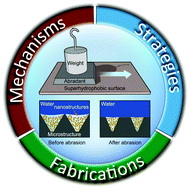Robust superhydrophobicity: mechanisms and strategies
Abstract
Superhydrophobic surfaces hold great prospects for extremely diverse applications owing to their water repellence property. The essential feature of superhydrophobicity is micro-/nano-scopic roughness to reserve a large portion of air under a liquid drop. However, the vulnerability of the delicate surface textures significantly impedes the practical applications of superhydrophobic surfaces. Robust superhydrophobicity is a must to meet the rigorous industrial requirements and standards for commercial products. In recent years, major advancements have been made in elucidating the mechanisms of wetting transitions, design strategies and fabrication techniques of superhydrophobicity. This review will first introduce the mechanisms of wetting transitions, including the thermodynamic stability of the Cassie state and its breakdown conditions. Then we highlight the development, current status and future prospects of robust superhydrophobicity, including characterization, design strategies and fabrication techniques. In particular, design strategies, which are classified into passive resistance and active regeneration for the first time, are proposed and discussed extensively.



 Please wait while we load your content...
Please wait while we load your content...